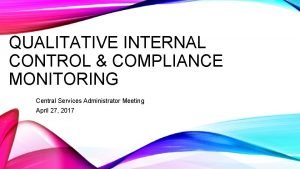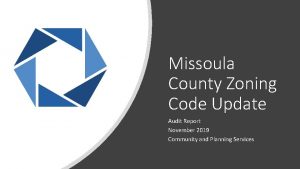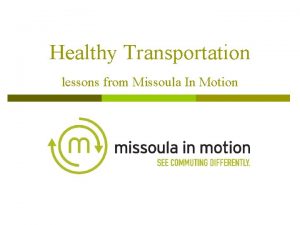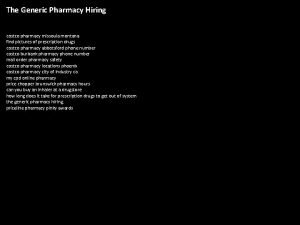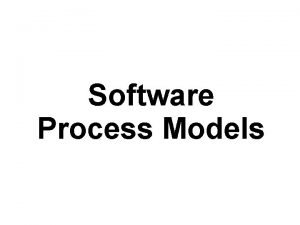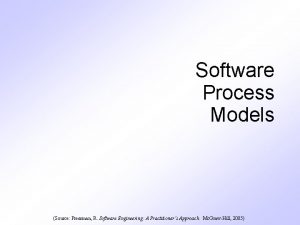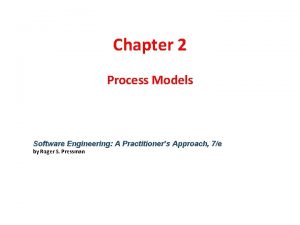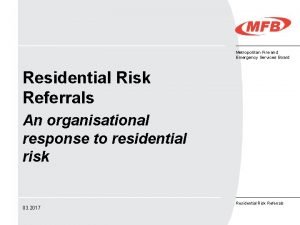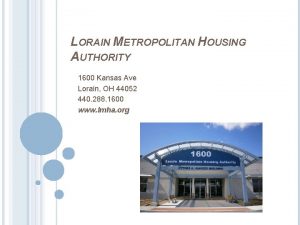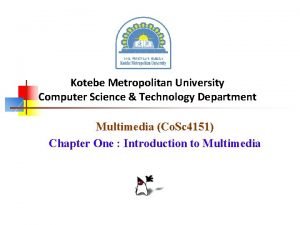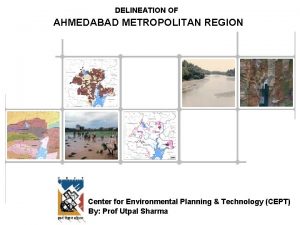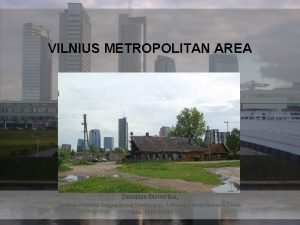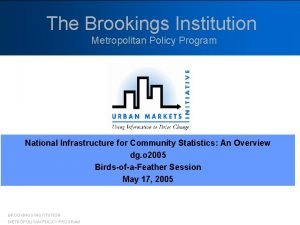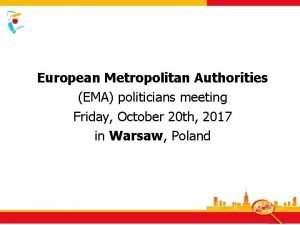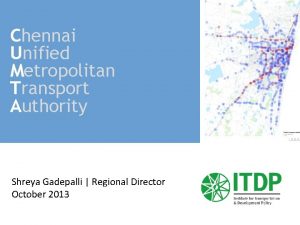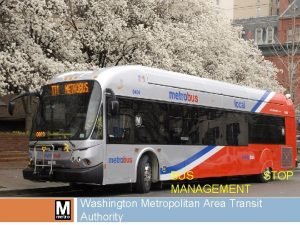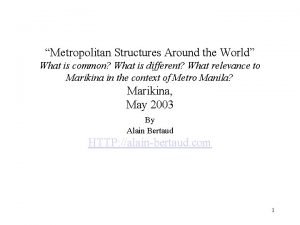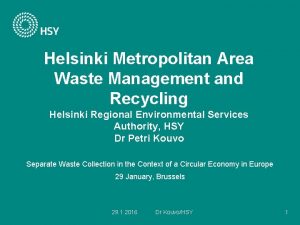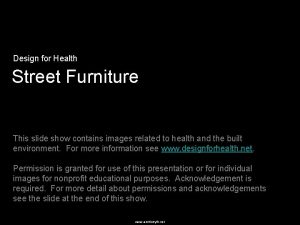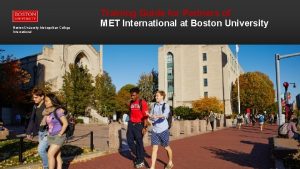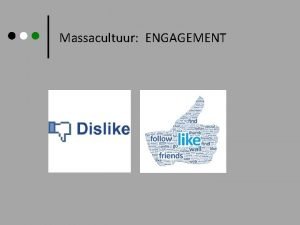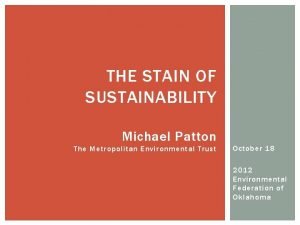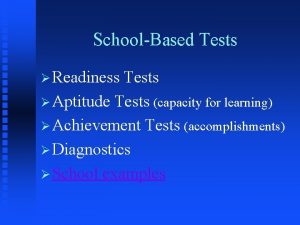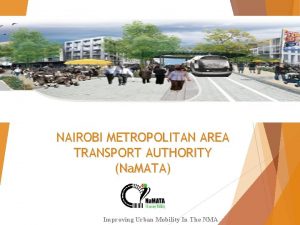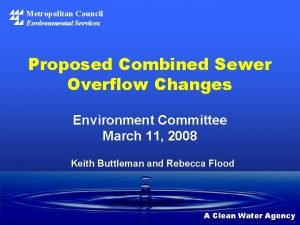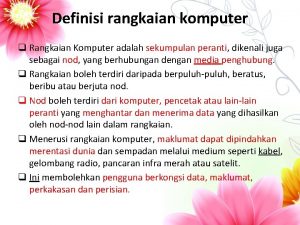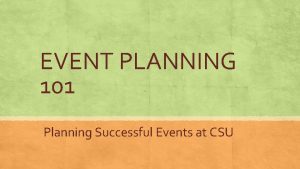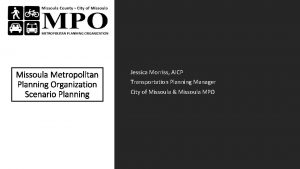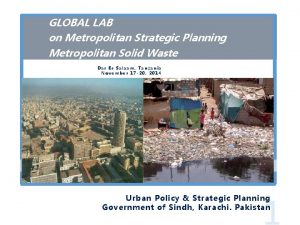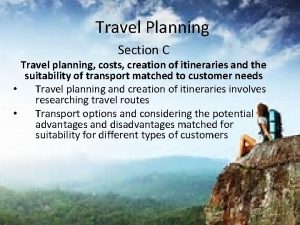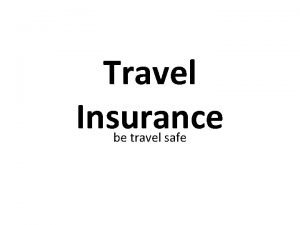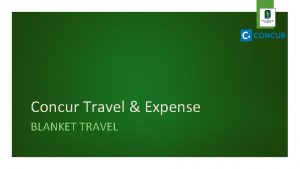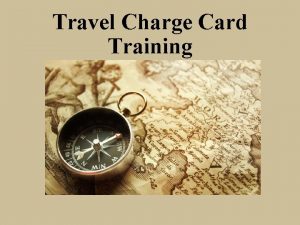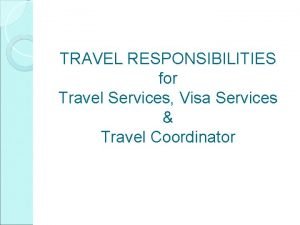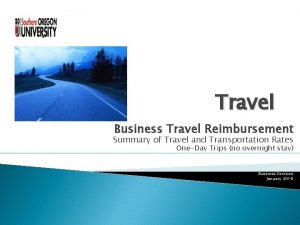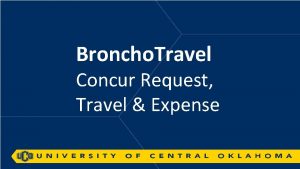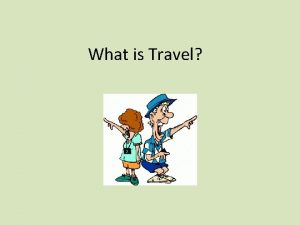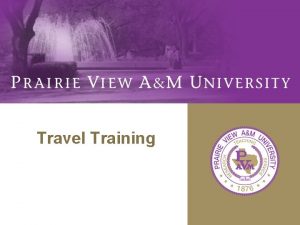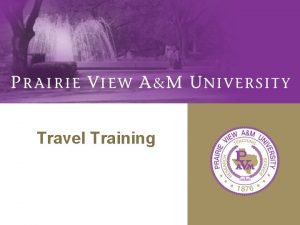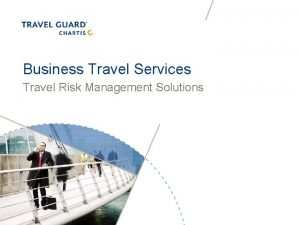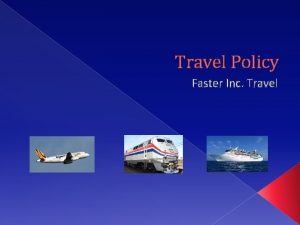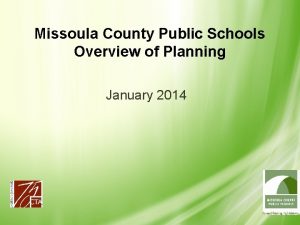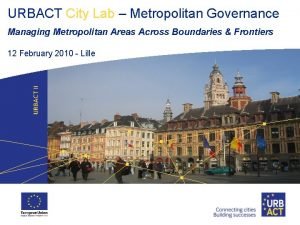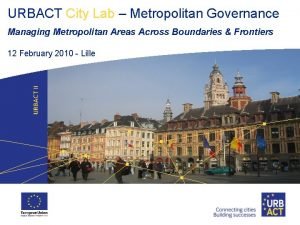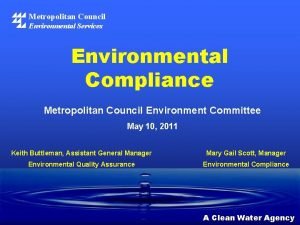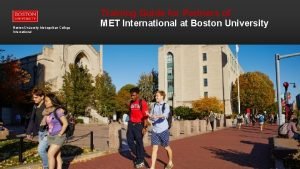Travel Modeling 101 For the Missoula Metropolitan Planning










































- Slides: 42

Travel Modeling 101 For the Missoula Metropolitan Planning Organization June 15, 2010 1

Opening the Black Box Missoula MPO Travel Demand Model Evaluation and Enhancement 2

The Four Steps Transportation Networks Transportation Supply Traffic Analysis Zone and Data Transportation Demand Trip Generation How many trips? Trip Distribution Where will they go? Feedback Mode Choice What mode? Trip Assignment What route? Roadway / Transit Results Reports Missoula MPO Travel Demand Model Evaluation and Enhancement 3

Model Inputs and Outputs Inputs Outputs Transportation Networks Trips by Mode Socioeconomic Data Traffic Volumes External Data Congested Speeds Special Generators Transit Volumes Model Parameters Bike / Ped Volumes Summary Information Missoula MPO Travel Demand Model Evaluation and Enhancement 4

Model Inputs and Outputs Inputs Transportation Networks Socioeconomic Data External Data Special Generators Model Parameters • Roadway Networks – Contains roadway characteristics • Speed Limit • Number of Lanes • Roadway Type (Freeway, arterial, etc. ) • Area Type (CBD, Urban, Suburban, Rural) Missoula MPO Travel Demand Model Evaluation and Enhancement 5

Model Inputs and Outputs Inputs Transportation Networks Socioeconomic Data External Data Special Generators Model Parameters • Transit networks – Route locations – Service frequency – Park and rides • Non-motorized networks – Bike/Ped facilities – Based on the roadway network (sidewalk availability) – Also includes off-street paths Missoula MPO Travel Demand Model Evaluation and Enhancement 6

Model Inputs and Outputs Inputs Transportation Networks Socioeconomic Data External Data Special Generators Model Parameters • Identifies demand for travel • Household data – Required: • Total Housholds – Optional: • Average household size • Median household income • Employment data – By Type • • Retail Service Basic/Industrial Optional: – Education – Health Care – Leisure/Recreation Missoula MPO Travel Demand Model Evaluation and Enhancement 7

Model Inputs and Outputs Inputs Transportation Networks Socioeconomic Data External Data Special Generators • Identify travel to/from the region • Identify travel through the region • Based on data from MDT Model Parameters Missoula MPO Travel Demand Model Evaluation and Enhancement 8

Model Inputs and Outputs Inputs Transportation Networks Socioeconomic Data External Data Special Generators Model Parameters • Unique locations – Not well represented by employment data – University of Montanna • Generate trips based on faculty, staff, and enrollment • Allocate trip-ends based on address data Missoula MPO Travel Demand Model Evaluation and Enhancement 9

Model Inputs and Outputs Inputs Transportation Networks Socioeconomic Data External Data Special Generators Model Parameters • Represent the way people behave – How many trips are made? – How far will people travel? – What impacts decisions about travel mode? – How does congestion impact travel? • Source Data Required – Mostly borrowed from other areas – Local data wherever possible Missoula MPO Travel Demand Model Evaluation and Enhancement 10

Model Inputs and Outputs • Information about each trip – Start/end – Time of day – Mode of travel – Purpose of trip – Trip time and distance Outputs Trips by Mode Traffic Volumes Congested Speeds Transit Volumes Bike / Ped Volumes Summary Information Missoula MPO Travel Demand Model Evaluation and Enhancement 11

Model Inputs and Outputs • By Time of Day Trips by Mode – Daily – AM & PM Peak Hour (less accuracy) • Turn Movements – Can be estimated with assistance of base-year counts Traffic Volumes Congested Speeds Transit Volumes • Congested speed based on volume. Bike / Ped Volumes Summary Information Missoula MPO Travel Demand Model Evaluation and Enhancement 12

Model Inputs and Outputs • Transit Trips by Mode – By Time of Day Traffic Volumes • Peak and Off-Peak • Daily sum – By route or route group Congested Speeds • Route-level data is less accurate • Bike / Pedestrian – Short trip demand is the best tool for bike and pedestrian planning Transit Volumes Bike / Ped Volumes Summary Information Missoula MPO Travel Demand Model Evaluation and Enhancement 13

Model Inputs and Outputs • Performance Report Outputs Trips by Mode – Detailed summary of model results – Useful for planners and engineers • Planning Tools – Maps and charts – Results presented for easy understanding • • VMT, VHT, Delay Level of Service Trip Lengths Trip Patterns Traffic Volumes Congested Speeds Transit Volumes Bike / Ped Volumes Summary Information Missoula MPO Travel Demand Model Evaluation and Enhancement 14

Model Inputs and Outputs • The model is not a “Crystal Ball” – The model is a tool that can aid in the decision making process – Evaluate results with a bit of skepticism • The model is a way of organizing your assumptions Missoula MPO Travel Demand Model Evaluation and Enhancement 15

Summary: Model Run Data Needs • Roadway Improvement – Complete Project Description • Project Extents • New Configuration details – lanes, speed limit, bike/ped facilities, facility type • Land Use / Development Scenario – Number of Units • Households, employment (or square footage) – Access Details • Where will the development take access to the roadway system – Traffic Studies • ITE-based traffic studies are helpful in evaluating a project Missoula MPO Travel Demand Model Evaluation and Enhancement 16

Missoula MPO Travel Demand Model Enhancement EXAMPLE MODEL OUTPUT Missoula MPO Travel Demand Model Evaluation and Enhancement 17 17

Model Inputs and Outputs • The model can estimate level of service to help identify problem areas. Missoula MPO Travel Demand Model Evaluation and Enhancement 18

Household And Employment Growth Today Missoula MPO Travel Demand Model Evaluation and Enhancement 19

Household And Employment Growth Future Missoula MPO Travel Demand Model Evaluation and Enhancement 20

Travel Patterns Today Missoula MPO Travel Demand Model Evaluation and Enhancement 21

Travel Patterns Future Missoula MPO Travel Demand Model Evaluation and Enhancement 22

2010 Roadway Level of Service • PM Peak Hour Conditions – Uncongested – Congesting – Congested • Thicker lines indicate higher volume DRAFT Missoula MPO Travel Demand Model Evaluation and Enhancement

Traffic Difference • Example: Madison Street Bridge Closure – Traffic decrease – Traffic Increase DRAFT Missoula MPO Travel Demand Model Evaluation and Enhancement 24

Select Link/Zone Analysis • Track vehicles that use a link – Example: traffic using the Madison Street bridge • Track trips to and from a particular zone DRAFT Missoula MPO Travel Demand Model Evaluation and Enhancement 25

Transit Activity Map • Home-end stop activity • Non-home stop activity • Transfers • Transit Ridership – Directional from home to DRAFT Note: UM routes are shown at a smaller scale Missoula MPO Travel Demand Model Evaluation and Enhancement 26

Short Trips • Gauge potential bicycle facility demand • 3 -6 mile trips • 1 -3 mile trips • 0 -1 mile trips (different scale) DRAFT Missoula MPO Travel Demand Model Evaluation and Enhancement 27

Traffic Difference • Example: Madison Street Bridge Closure – Traffic decrease – Traffic Increase Diverted Volumes shown in thousands DRAFT Missoula MPO Travel Demand Model Evaluation and Enhancement 28

Bringing the Model Up to Date MODEL STEPS Missoula MPO Travel Demand Model Evaluation and Enhancement 29

Trip Generation How Many Trips? • Keep track of more trip purposes • Better locate trips – Use population & income details – Track university trips • Include all trips – Walk, – Bike, – Transit, – Auto, –… Missoula MPO Travel Demand Model Evaluation and Enhancement 30

Trip Distribution Where Will They Go? The Gravity concept can be used to model travel! • Match trips from home to – Work, Shopping, Appointments, School, Recreation, etc… • Match trips between – Work , shop, appointment, etc. • Calibrate a gravity model based on local data Missoula MPO Travel Demand Model Evaluation and Enhancement 31

Mode Choice What Mode? Can I get a ride? Is it close enough to bike? How much $ is parking? How about the bus? • This will be a new model component! • Choose between: – Drive, – Carpool, – Walk, – Bicycle, – Transit Missoula MPO Travel Demand Model Evaluation and Enhancement 32

Mode Choice What Route? • Find the best route from A to B • Avoid congestion – Especially in the peak travel times – Use Equilibrium (capacity constrained) assignment Missoula MPO Travel Demand Model Evaluation and Enhancement 33

Testing the Model MODEL VALIDATION Missoula MPO Travel Demand Model Evaluation and Enhancement 34

Matching Counts • How does the model work for today – Statistics • • R-Squared % RMSE Volume / Count Ratio Etc… – Screenlines – Corridor Review – Highest Errors Missoula MPO Travel Demand Model Evaluation and Enhancement 35

Testing Sensitivity • Dynamic Validation – Observe how the model reacts changes • Test big and small changes • Test the base and forecast year – Do results make sense? Missoula MPO Travel Demand Model Evaluation and Enhancement 36

Missoula MPO Travel Demand Model Enhancement TRAVEL MODEL & ’S Missoula MPO Travel Demand Model Evaluation and Enhancement ’S 37 37

Testing Demand Changes – Evaluate base, interim, and forecast year datasets – Consider testing large development proposals (e. g. , over 200 households or employees) • Use the model’s trip distribution to compare to traffic study assumptions • Cross-check development model runs with ITE -based traffic studies – Use the model to test very small developments – Test unreasonable changes to the jobs/housing balance Missoula MPO Travel Demand Model Evaluation and Enhancement

Testing Roadway Changes • D – Test large and medium-scale capacity changes – Test different roadway alternatives – Test a comprehensive roadway plan – consider forecast conditions — Test scenarios that do not impact system capacity — Try to model very small capacity or speed changes Missoula MPO Travel Demand Model Evaluation and Enhancement 39

Non-motorized Results – Focus on potential non-motorized demand • E. g. , 1, 3, and 6 mile trip bandwidths • Identify good places for infrastructure improvements – Consider non-motorized model results to be a rough estimate • The model is only one tool to aid in analysis – Expect detailed numbers • YES: “There is a high demand for a new bike lane in this corridor” • NO: “This new bike lane will result in X new bike trips” Missoula MPO Travel Demand Model Evaluation and Enhancement 40

Transit Results – Evaluate major system adjustments – Test large route changes – Focus on a system-wide results – Test fine tuning of route alignments – Expect detailed forecasts by transit route or transit stop • This information is available, but must be interpreted carefully by a transit professional Missoula MPO Travel Demand Model Evaluation and Enhancement 41

THANK YOU! Missoula MPO Travel Demand Model Evaluation and Enhancement 42
 Helen erickson biography
Helen erickson biography Relational vs dimensional data modeling
Relational vs dimensional data modeling Missoula technology development center
Missoula technology development center Compliance monitoring missoula
Compliance monitoring missoula Missoula county zoning
Missoula county zoning Missoula in motion
Missoula in motion Costco pharmacy cabot road
Costco pharmacy cabot road Lake missoula
Lake missoula Partnership health missoula
Partnership health missoula A generic process framework for software engineering
A generic process framework for software engineering Prototyping model in software engineering with diagram
Prototyping model in software engineering with diagram Communication planning modeling construction deployment
Communication planning modeling construction deployment Evolutionary software process models
Evolutionary software process models Metropolitan fire and emergency services board
Metropolitan fire and emergency services board Lorain metropolitan housing
Lorain metropolitan housing Kotebe metropolitan university website
Kotebe metropolitan university website Ahmedabad metropolitan region
Ahmedabad metropolitan region Vilnius metropolitan area
Vilnius metropolitan area Brookings metropolitan policy program
Brookings metropolitan policy program Art lovers can visit the - metropolitan museum of art
Art lovers can visit the - metropolitan museum of art Habibmetro car finance
Habibmetro car finance Metropolitan area network
Metropolitan area network Stark metropolitan housing authority jobs
Stark metropolitan housing authority jobs Fthun
Fthun Unified metropolitan transport authority
Unified metropolitan transport authority Metropolitan area
Metropolitan area Metropolitan structures
Metropolitan structures Jollibee sole proprietorship
Jollibee sole proprietorship Metropolitan
Metropolitan Metropolitan design center
Metropolitan design center Boston university metropolitan college
Boston university metropolitan college Guerrilla girls’ metropolitan museum poster
Guerrilla girls’ metropolitan museum poster Jade patton
Jade patton Gesell developmental checklist
Gesell developmental checklist Nairobi metropolitan transport authority
Nairobi metropolitan transport authority Metropolitan council environmental services
Metropolitan council environmental services Definisi rangkaian
Definisi rangkaian Event planning 101 checklist
Event planning 101 checklist Iso 22301 utbildning
Iso 22301 utbildning Typiska novell drag
Typiska novell drag Nationell inriktning för artificiell intelligens
Nationell inriktning för artificiell intelligens Vad står k.r.å.k.a.n för
Vad står k.r.å.k.a.n för Varför kallas perioden 1918-1939 för mellankrigstiden?
Varför kallas perioden 1918-1939 för mellankrigstiden?



